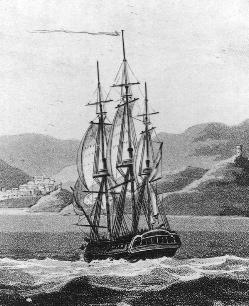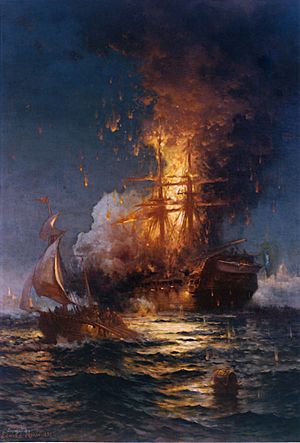USS Philadelphia (1799) facts for kids
 |
|
Quick facts for kids History |
|
|---|---|
| Name | USS Philadelphia |
| Cost | $179,349 |
| Laid down | November 14, 1798 |
| Launched | November 28, 1799 |
| Commissioned | April 5, 1800 |
| Fate | Captured October 31, 1803, re-captured and burned by the U.S. Navy February 16, 1804 |
| General characteristics | |
| Class and type | Philadelphia-class frigate |
| Tonnage | 1240 |
| Length | 157 ft (48 m) between perpendiculars |
| Beam | 39 ft (12 m) |
| Depth | 13 ft 6 in (4.11 m) |
| Complement | 307 officers and crew |
| Armament |
|
The USS Philadelphia was a large sailing ship called a frigate. It weighed 1240 tons and had 36 guns. This ship was the second one in the United States Navy to be named after the city of Philadelphia.
The ship was first called City of Philadelphia. People in Philadelphia built it for the U.S. government between 1798 and 1799. They raised $100,000 in just one week to pay for it! Josiah Fox designed the ship. Samuel Humphreys, Nathaniel Hutton, and John Delavue built it. William Rush carved its decorations.
Work on the ship started around November 14, 1798. It was launched into the water on November 28, 1799. The ship officially joined the Navy on April 5, 1800. Captain Stephen Decatur, Sr. was its first commander. Later, the ship was captured by pirates in Tripoli. Captain William Bainbridge was in charge then. But another brave officer, Stephen Decatur (the son of the first captain), led a daring mission. His team burned the ship down so the pirates couldn't use it.
Contents
The Ship's Journeys and Battles
The USS Philadelphia first sailed to the West Indies. The United States was fighting a short, undeclared war with France there. This war was called the Quasi-War. The Philadelphia arrived in May 1800. It took over duties from another ship, the Constellation. During this time, the Philadelphia captured five French armed ships. It also rescued six merchant ships that the French had taken.
In March 1801, the ship returned home. It was then told to get ready for a year-long trip to the Mediterranean Sea. It would join a group of ships led by Commodore Richard Dale. Captain Samuel Barron took command of the Philadelphia at his own request. The group of ships arrived in Gibraltar on July 1. The Philadelphia was ordered to patrol the waters near Tripoli. This was because in May 1801, the ruler of Tripoli, Pasha Yusuf Karamanli, had threatened war. He had also captured U.S. merchant ships for money. This conflict became known as the First Barbary War.
The Philadelphia left Gibraltar for the United States in April 1802. It arrived in mid-July. The ship was not used until May 21, 1803. Then, it was put back into service. Its sixteen 9-pounder guns were replaced with sixteen more powerful 32-pounder guns. On July 28, 1803, it sailed back to the Mediterranean. Captain William Bainbridge was now in command. On August 24, it reached Gibraltar. Two days later, Captain Bainbridge's crew rescued an American ship called Celia. It had been captured by a Moroccan warship. Both ships were brought back to Gibraltar.
Captured by Pirates

During the First Barbary War, the Philadelphia and another ship, USS Vixen, patrolled near Tripoli. On October 31, 1803, the Philadelphia was chasing a Libyan navy ship. It ran aground on a hidden reef about 2 miles (3.2 km) from Tripoli Harbor.
Captain William Bainbridge tried to get the ship unstuck. He tried to use the sails and threw three anchors into the water. He also moved the guns to the back of the ship to lighten the front. But a strong wind and rising waves pushed the ship even further onto the reef.
He then ordered the crew to throw many cannons, water barrels, and other heavy items overboard. This was to make the ship lighter. But it still didn't work. They even cut down the front mast in a last try to lighten the ship. To stop the Tripoli pirates from using the ship, Captain Bainbridge gave a sad order. He told his crew to drill holes in the ship's bottom. They also wet the gunpowder and set the sails on fire. All other weapons were thrown overboard. Then, they surrendered. The Pasha's officials captured the American officers and crew. They were held as prisoners of war.
The Daring Burning Mission
The Tripoli pirates eventually managed to get the Philadelphia unstuck. The Americans knew that this warship was too valuable to be left in enemy hands. So, the U.S. Navy decided to get it back or destroy it. The United States had captured a small Tripolitan ship called the Mastico. They renamed it Intrepid. They changed its masts and sails to make it look like a local ship.
Lieutenant Stephen Decatur, the son of the Philadelphia's first captain, led a team. There were 83 volunteers for this dangerous mission. On February 16, 1804, under the cover of night, Decatur sailed the Intrepid close to the Philadelphia. They pretended to be a ship in trouble that had lost its anchors in a storm. They asked for a place to tie up.
The Americans then quickly boarded the Philadelphia. They made sure the ship could not sail again. Then, they set the ship on fire right there in Tripoli Harbor. Decatur's team had only one person injured. They killed at least 20 Tripolitans.
It is said that Britain's famous Admiral Viscount Nelson called this act "the most bold and daring act of the Age." However, we are not completely sure if he actually said this.
The American crew members captured in 1803 were set free later. This happened because of the 1805 Treaty of Tripoli, which ended the war. The Philadelphia's anchor was returned to the United States on April 7, 1871. Mehmed Halet Pasha, the Ottoman governor, gave it to the captain of the visiting Guerriere.
The Ship in Popular Culture
The burning of the USS Philadelphia is shown in the US DLC (downloadable content) for the video game Age of Empires III: Definitive Edition.
See also
- List of sailing frigates of the United States Navy
- List of ships captured in the 19th century
- Bibliography of early American naval history


